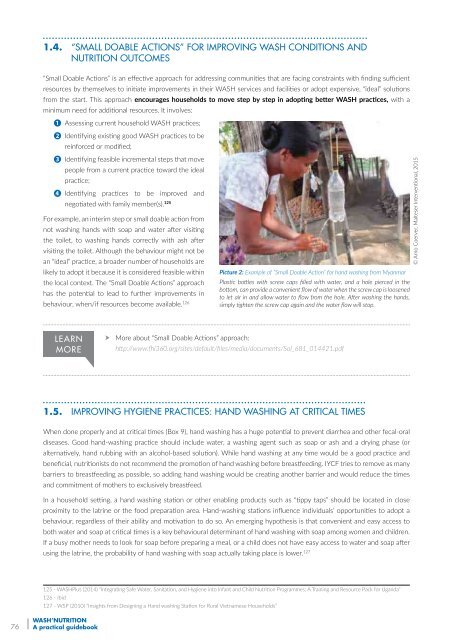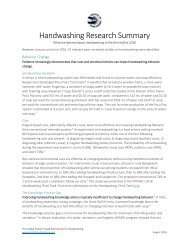WASH’ Nutrition
manuel_wash_nutrition_online
manuel_wash_nutrition_online
You also want an ePaper? Increase the reach of your titles
YUMPU automatically turns print PDFs into web optimized ePapers that Google loves.
1.4. “Small Doable Actions” for improving WASH conditions and<br />
<strong>Nutrition</strong> outcomes<br />
“Small Doable Actions” is an effective approach for addressing communities that are facing constraints with finding sufficient<br />
resources by themselves to initiate improvements in their WASH services and facilities or adopt expensive, “ïdeal” solutions<br />
from the start. This approach encourages households to move step by step in adopting better WASH practices, with a<br />
minimum need for additional resources. It involves:<br />
1 Assessing current household WASH practices;<br />
2 Identifying existing good WASH practices to be<br />
reinforced or modified;<br />
3 Identifying feasible incremental steps that move<br />
people from a current practice toward the ideal<br />
practice;<br />
4 Identifying practices to be improved and<br />
negotiated with family member(s). 125<br />
For example, an interim step or small doable action from<br />
not washing hands with soap and water after visiting<br />
the toilet, to washing hands correctly with ash after<br />
visiting the toilet. Although the behaviour might not be<br />
an “ideal” practice, a broader number of households are<br />
likely to adopt it because it is considered feasible within<br />
the local context. The “Small Doable Actions” approach<br />
has the potential to lead to further improvements in<br />
behaviour, when/if resources become available. 126<br />
Picture 2: Example of “Small Doable Action” for hand washing from Myanmar<br />
Plastic bottles with screw caps filled with water, and a hole pierced in the<br />
bottom, can provide a convenient flow of water when the screw cap is loosened<br />
to let air in and allow water to flow from the hole. After washing the hands,<br />
simply tighten the screw cap again and the water flow will stop.<br />
© Arno Coerver, Malteser Interventional, 2015<br />
LEARN<br />
MORE<br />
More about “Small Doable Actions” approach:<br />
http://www.fhi360.org/sites/default/files/media/documents/Sol_681_014421.pdf<br />
1.5. Improving hygiene practices: hand washing at critical times<br />
When done properly and at critical times (Box 9), hand washing has a huge potential to prevent diarrhea and other fecal-oral<br />
diseases. Good hand-washing practice should include water, a washing agent such as soap or ash and a drying phase (or<br />
alternatively, hand rubbing with an alcohol-based solution). While hand washing at any time would be a good practice and<br />
beneficial, nutritionists do not recommend the promotion of hand washing before breastfeeding. IYCF tries to remove as many<br />
barriers to breastfeeding as possible, so adding hand washing would be creating another barrier and would reduce the times<br />
and commitment of mothers to exclusively breastfeed.<br />
In a household setting, a hand washing station or other enabling products such as “tippy taps” should be located in close<br />
proximity to the latrine or the food preparation area. Hand-washing stations influence individuals’ opportunities to adopt a<br />
behaviour, regardless of their ability and motivation to do so. An emerging hypothesis is that convenient and easy access to<br />
both water and soap at critical times is a key behavioural determinant of hand washing with soap among women and children.<br />
If a busy mother needs to look for soap before preparing a meal, or a child does not have easy access to water and soap after<br />
using the latrine, the probability of hand washing with soap actually taking place is lower. 127<br />
125 - WASHPlus (2014) “Integrating Safe Water, Sanitation, and Hygiene into Infant and Child <strong>Nutrition</strong> Programmes; A Training and Resource Pack for Uganda”<br />
126 - Ibid<br />
127 - WSP (2010) “Insights from Designing a Hand washing Station for Rural Vietnamese Households”<br />
76<br />
<strong>WASH’</strong><strong>Nutrition</strong><br />
A practical guidebook



